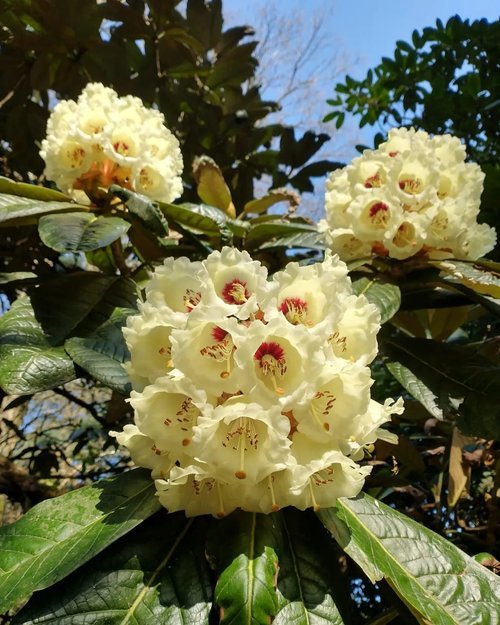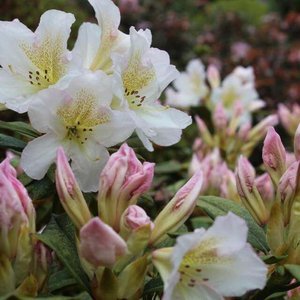LISTEN TO THE NEW EPISODE OF GROWING LEONARDSLEE
Discover The Story Of Our Sister Estate Leonardslee’s Rhododendrons
Welcome to the Growing Leonardslee podcast. In each episode, Adam Streeter, the general manager of Leonardslee, talks with members of the team about everything from the history of the gardens and restoration challenges to wine and wallabies and everything in between.
It’s a regular peek behind the scenes to hear stories from all those involved both past and present, and we’ll also talk about what the future holds for the estate. It's never a dull day when you're Growing Leonardslee!
In the sixth episode of the 'Growing Leonardslee' podcast, general manager Adam Streeter goes deeper into the world of rhododendrons at Leonardslee Gardens, in discussion with head gardener Jamie Harris. Previously, the podcast explored the historical significance of rhododendrons at Leonardslee and how their presence put the garden on the map. Now, the focus shifts to the measures taken to ensure the survival and enjoyment of these magnificent plants for generations to come.
The gardens were saved by the Streeter family in 2017, following eight years of closure and neglect by previous owners, and then restored and opened by the family in 2019. It was one of the biggest restoration projects in England since the Lost Gardens of Heligan project.
Jamie and Adam discuss in the podcast the importance of preserving and protecting the rhododendrons. The need for vigilance in safeguarding these plants from potential threats, such as storms or diseases. To address this, Leonardslee Gardens has partnered with the Duchy College in Cornwall to micro-propagate some of our most important Rhododendron specimens. This involves breaking down flower buds into individual cells, which are then placed in a gel-like substance with added chemicals to nurture the growth of seedlings.
By micro-propagating the 40-odd specimens in their national collection, Leonardslee aims to create an exact replica of the parent plants, ensuring that future generations can enjoy the same captivating beauty that current visitors experience. This not only helps maintain the continuity of these important plants in the garden but also serves as a preventive measure against potential outbreaks of diseases or severe weather conditions that could damage or destroy the rhododendrons.
Rhododendron Rivalry: An Invasive Tale Of Plant Power
Adam and Jamie then discuss Rhododendron ponticum, a beautiful but invasive plant species. It poses a significant threat to other plant species that can fall victim to the destructive Phytopthora Ramorum disease. This is caused by an organism capable of wiping out large collections of rhododendrons, similar perhaps to how COVID-19 has affected human populations.
Interestingly, the same Polymerase Chain Reaction (PCR) tests used for detecting COVID-19 are also employed to determine if plants are infected with Ramorum disease. So far, no infections have been found.
Preserving rhododendron species requires a delicate balance between conservation and management, including some heavy pruning on occasion. In addition to monitoring for diseases, the gardeners must also remove certain rhododendron species, like R. ponticum.
However, this is not the only species that warrants management. Rhododendron luteum, while not invasive, is a vigorous grower and requires hard pruning to keep it at a manageable level. Selective pruning opens up light onto the ground, allowing for the regeneration of the forest floor and the growth of bulbs, as well as creating pockets for new plantings.
As the woodland plants at Leonardslee Gardens come to life during the spring, it serves as a reminder of the immense effort and dedication that has gone into reviving the once-forgotten garden.
Members who return to the gardens on a regular basis can now witness the remarkable transformation the team has achieved through hard work and perseverance. During the years when the gardens were closed and neglected, the impact was significant. The lack of pruning and maintenance, combined with the overgrowth of invasive species, led to the decline of the once-vibrant rhododendron collections.
Jamie says that one of the primary challenges at Leonardslee Gardens was the need for restoration pruning. Many flowers had grown well above head height, making it difficult for visitors to appreciate their beauty and fragrance. To address this issue, Elliott Chandler and other members of the gardening team attended a rhododendron pruning course at Millais Nurseries, where they learned new techniques to tackle the overgrowth problem.
Snip, Shape, And Bloom: The Art Of Rhododendron Restoration
Conventional wisdom suggests hard pruning rhododendrons after flowering around May or June, but the Millais course highlighted the benefits of pruning before flowering in early spring, around mid-March. This timing coincides with the rising sap through the stems.
Although this method sacrifices the flowers for the current year, it ensures strong regrowth and a quicker recovery for the plant. This results in flowers returning within a few years, as opposed to the extended recovery time associated with later pruning.
Pruning has primarily been focused on plants in the rock garden and other important areas. The team has been hard pruning the plants in March and early April, followed by immediate mulching and feeding to provide the necessary nutrients for recovery and to help conserve moisture during summer.
The pruning efforts at Leonardslee Gardens are not indiscriminate. The team targets specific plants that have become leggy, grown too tall, blocked views or have flowers situated too high. The aim is to improve the shape of the plant and bring the flowers down to eye level for visitors to enjoy.
However, not all rhododendrons can be hard-pruned. Species and hybrid rhododendrons with smooth, shiny, or flaky bark should not be pruned, as they are unlikely to sprout.
The team’s newfound knowledge has been invaluable in guiding the pruning efforts at Leonardslee Gardens. By adopting this innovative approach to rhododendron pruning, the team is ensuring the long-term health and beauty of these plants. The results of their hard work will be appreciated by visitors and garden enthusiasts alike for years to come.
Leonardslee’s Blossoming Ambitions And Alliances
The team at Leonardslee Gardens is not solely focused on rhododendrons; new plantings are being introduced to provide additional seasonal interest. For example, clearance work in the coronation garden revealed historical notes indicating the presence of a magnolia grove.
The team now plans to plant magnolias in this area. New plantings elsewhere will include summer-flowering or later-flowering rhododendrons, such as ‘Polar Bear’ and Rhododendron arborescens, and winter-flowering varieties like Rhododendron dauricum 'Mid-Winter.'
The team's ambitious plans extend to expanding the existing national collection of rhododendrons, which consists of 42 specimens. There are many Loderi and Leonardslee-related hybrids that are no longer found in the garden, such as ‘Leonardslee Cream’, ‘Leonardslee Flame’, and ‘Leonardslee Gem’ to name but a few.
The challenge is sourcing these rare rhododendrons. The team's affiliation as an RHS Partner and with the Rhododendron, Camellia, and Magnolia Group (RCM Group) provides valuable connections to private collectors who may possess these coveted plants.
Leonardslee Gardens is part of a thriving network that includes other exceptional gardens in the region, such as Nymans, High Beeches and Wakehurst Place. Visitors who appreciate the beauty of Leonardslee Gardens can explore these locations too, showcasing the wealth of horticultural treasures found in Sussex and the Southeast of England.
Leonardslee's Loving Approach To Rhododendron Care And Conservation
Currently, the Leonardslee team is going around all the specimens in the estate’s national collection, giving each plant a feed and mulch, clearing around the base, and ensuring they have the right light levels. This level of care is crucial in preparing the plants for potential environmental challenges, such as droughts during the summer months.
The team is vigilant in monitoring pests and diseases, having consulted with the Animal Plant Health Agency (APHA) for guidance on what to look out for. Regular testing for Phytophthora ramorum, a fungus-like organism causing root and stem base decay, is a part of their routine maintenance.
Educating visitors about the importance of the rhododendron collection is another priority for the team at Leonardslee. They plan to create a trail and map for the collection, so visitors can appreciate and enjoy these plants and understand their significance. This education extends to the do's and don'ts when visiting the gardens, such as not climbing on the plants, some of which are hundreds of years old and exist only here at Leonardslee.
The garden team takes extra precautions to prevent the spread of pests and diseases, such as wearing boots designated for use only within the garden and using antiseptic spray on tools after each pruning session. They urge visitors to be mindful of the importance of the collection and to respect the plants during their visit, please!
Leonardslee's rhododendron collection has gained recognition for its historical significance. The RCM group donated 25 specimens to tell the story of the Rhododendron genus to King Charles as part of the coronation celebrations, with plants ‘Loderi King George’ and ‘Loderi Sir Joseph Hooker’ being selected for planting at Sandringham on the King's estate.
If you are inspired to grow rhododendrons at home, then do visit the garden nursery shop on the estate, and tune in to this podcast and future editions, where we will continue to explore the wonderful world of rhododendrons at Leonardslee Lakes and Gardens.







